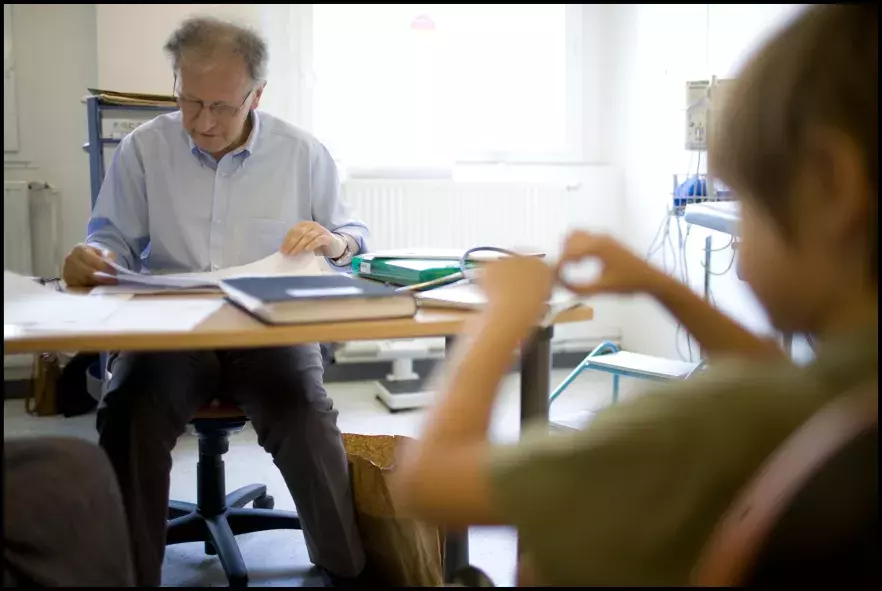Published on 29.11.2019
There is no science without observation, or experimentation. It is this desire to bring science and medicine together which seems to guide the fascinating journey of Alain Fischer, professor at the Collège de France, founding member of Imagine. Experiment to understand seems to be the foundation of his clinical and research work.
A journey centered on immunology
It all started with studying the immune system, this mechanism that protects us from attacks from viruses, bacteria, sometimes even against our own cells. And Alain Fischer tackled this world with a dual approach. Because, as he repeated “I wanted to be a doctor first, but I always wanted to be a doctor-researcher, for me it is a single discipline. A patient or rather his disease raises a question, more or less addressed at time T. Yet it is essential to understand his disease to be able to treat it.”
Then, as he said himself, he fell in love with the department of Claude Griscelli, father of the immunodeficiency study in France, at Necker-Enfants Malades hospital AP-HP where he did his first internship. He then decided to turn towards pediatrics. All the elements came together and the connections with Claude Griscelli continued as it is with him, Arnold Munnich, Stanislas Lyonnet and Corinne Antignac that they created Imagine Institute, dedicated to rare genetic diseases, for which Alain Fischer was the director until 2016.
Explore to treat better
Alain Fischer focuses his work on immunodeficiencies, diseases characterized by a defect in the immune system causing susceptibility to infections, allergies, autoinflammatory diseases and cancers. He devoted himself to identifying the genetic and molecular bases of these diseases, which include severe combined immunodeficiencies (SCID), a rare and hereditary blood disease related to chromosome X. Among these children was the case of a young German boy, studied by Geneviève de Saint-Basile, in who the mutation was partially and naturally corrected allowing him to glimpse the potential of gene therapy in these diseases. “Only patients that could benefit from a bone marrow transplant from a compatible donor could then pull through, explains the doctor-researcher. In this child, we discovered that a small number of corrected cells could restore the activity of white blood cells, inactive until then, and so fight the infection. In addition, taking into account the very long lifetime of these cells, the abnormality could be permanently treated. If gene therapy was not effective in this case, it would never work...”
The first successes of gene therapy
In 1999, with Prof. Salima Hacein-Bey-Abina and Prof. Marina Cavazzana (at the time Inserm Unit 768 Normal and pathological development of the immune system, Biological Therapy Department and Pediatric Hematology and Immunology Unit, Necker-Enfants Malades hospital AP-HP, Paris Descartes University, Paris), they treated the first children with SCID by gene therapy. In reality, the treatment was a lot more complex than it seemed. “It was necessary to take a bone marrow sample from the children, isolate the stem cells [mother of all blood cells Ed.] in order to insert a normal copy of the defective gene, he explained. A virus like a Trojan horse serves to integrate the gene into the genetic material.”
Quickly, white blood cells were detected in the young patients treated. The evidence is there that gene therapy can work. However, there is still a lot to understand and the death of one of the children as a result of a leukemia induced because of insertion of the repaired gene close to an oncogene, a gene which accelerates the occurrence of cancer, tainted the success.
I wanted to be a doctor first, but I always wanted to be a doctor-researcher, for me it is a single discipline. A patient or rather his disease raises a question, more or less addressed at time T. Yet it is essential to understand his disease to be able to treat it.
Therefore, the whole team returned to work to develop a less toxic technology to insert the genes. And it took 7 years for that solution to emerge. “Research in medicine requires a lot of patience and modesty, recalls Alain Fischer. Since then, gene therapy has shown its efficacy in several diseases, other immunodeficiencies, metabolic diseases, severe anemias - sickle cell anemia, beta-thalassemia - cancers, neuromuscular, ophthalmic diseases, and the trials multiply in neurology and in dermatological diseases.”
In addition, in 2015 the Japanese committee of scientists, who awarded the Japan Prize to Alain Fischer at the same time as to his distinguished colleague Theodore Friedman, praised “gene therapy is one of the most advanced and revolutionary treatments of the 21st century for genetic and refractory diseases. In recent years, the clinical efficacy of the therapy in various refractory and fatal diseases has been observed more and more.”
Today, Prof. Alain Fischer endeavors to spread knowledge about immunology, particularly through his classes at the Collège de France, and to fight against spreading incorrect news in science, like the disengagement of French people towards vaccines, but he also continues to analyze immunodeficiencies. And if he is asked what led him to create Imagine Institute, dedicated to rare genetic diseases, with Claude Griscelli, Arnold Munnich, Stanislas Lyonnet and Corinne Antignac in 2007, he recalls that the patients concerned have the same right as other and that rare diseases pave the way to knowledge: “Sometimes rare diseases are an “extreme form” of a common disease and shed light on very complex mechanisms, even open up new therapeutic avenues. The Institute alone symbolizes the importance of connections between medicine and science. An approach to which computer literacy must now be added”, he concludes.

